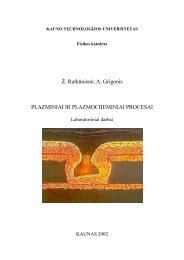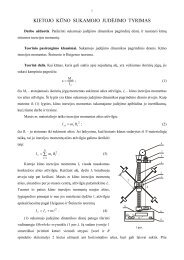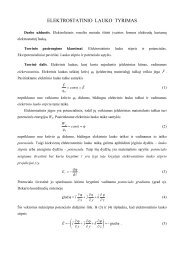PROCEEDINGS OF THE 7 INTERNATIONAL ... - Fizika
PROCEEDINGS OF THE 7 INTERNATIONAL ... - Fizika
PROCEEDINGS OF THE 7 INTERNATIONAL ... - Fizika
You also want an ePaper? Increase the reach of your titles
YUMPU automatically turns print PDFs into web optimized ePapers that Google loves.
D. Lesciute et al. / Medical Physics in the Baltic States 7 (2009) 16 - 19<br />
band at 1080 cm -1 is caused by symmetric vibration of<br />
PO2 and at 1240 cm -1 – by antisymmetric vibration of<br />
PO2 [7].<br />
3. Experimental<br />
Prostate samples were obtained from Vilnius<br />
University hospital Santariskiu Klinikos by means of<br />
cancerous tissue surgery. The prostate slices were<br />
taken from inner tissue and outer tissue. Such 10<br />
microns thick slices were prepared by microtome from<br />
frozen samples. Similar slices from neighbouring<br />
layers of the tissue were prepared for histological<br />
observation.<br />
a b<br />
Fig. 2. Optical images of two prostate tissue slices: a) taken from inner tissue;<br />
b) taken from outer tissue.<br />
Spectra were obtained using FTIR spectrometer Vertex<br />
70 combined with microscope “Hyperion 3000” from<br />
“Bruker” and with FPA MCT 64 × 64 detector. The<br />
resolution of the spectrometer was set to 8 cm -1 . Falsecolour<br />
images representing the distribution of<br />
cancerous cells in the tissue were obtained by<br />
integrating the area under the spectral band of specific<br />
amide I and amide II spectral bands. The OPUS<br />
software was used for this purpose.<br />
4. The results and discussions<br />
The samples - 20 microns slices of cancerous prostate<br />
tissue - were investigated in this work by using two<br />
methods: infrared absorption spectroscopy at selected<br />
points of the sample and infrared spectroscopical<br />
imaging of whole area of the sample. Firstly, the<br />
samples were analyzed visually and only areas of very<br />
different density (e.g. transparent or completely dark)<br />
have been chosen for the single point infrared<br />
measurements. Optical images of selected areas are<br />
presented in fig. 2. The optical images were captured<br />
with optical microscope set to ×15 magnification.<br />
18<br />
Optical density<br />
1.2<br />
1.0<br />
0.8<br />
0.6<br />
0.4<br />
0.2<br />
0.0<br />
3500 3000 2500 2000 1500<br />
Wavenumber, cm -1<br />
Fig. 3. FTIR absorption spectra of slice taken from outer<br />
prostate tissue: red – dark spots; blue – light spots.<br />
1000<br />
The IR spectra were recorded in 4000 – 900 cm -1 spectral<br />
region e.g. in the region where CaF2 support plate for the<br />
tissue slices is transparent. The spectra typical for<br />
transparent and dark areas of the slices taken from outer<br />
prostate tissue are presented in fig. 3.<br />
Close look to the spectra reveals that they correspond to<br />
the same type of the cells, just thickness of the slice<br />
corresponding to blue spectrum is larger than that<br />
corresponding to the red spectrum.<br />
Identification of the spectral bands is presented in table 1.<br />
The assignment was made using data obtained for other<br />
biological tissues [3].<br />
Table 1. Assignment of the spectral bands to normal<br />
vibrations<br />
Wave number<br />
(cm -1 )<br />
Assignment<br />
3295 Amide A (N-H bond)<br />
3050 Amide B<br />
2960 νas CH3<br />
2930 νas CH2<br />
2874 νs CH3<br />
2852 νs CH2<br />
1655 Amide I (νC=O, δC-N, δN-H)<br />
1545 Amide II (δ N-H, ν C-N)<br />
1476 δ CH2<br />
1380 δ CH3<br />
1240 νas PO - 2<br />
1170 νas CO-O-C<br />
1078 νs PO - 2<br />
1050 νs CO-O-C<br />
1030 νs C-O








